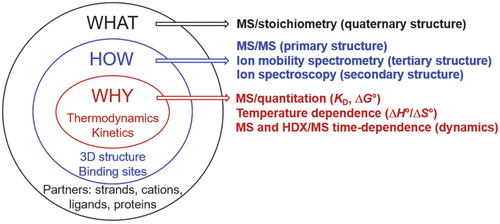当前位置:
X-MOL 学术
›
Acc. Chem. Res.
›
论文详情
Our official English website, www.x-mol.net, welcomes your
feedback! (Note: you will need to create a separate account there.)
Native Mass Spectrometry and Nucleic Acid G-Quadruplex Biophysics: Advancing Hand in Hand
Accounts of Chemical Research ( IF 16.4 ) Pub Date : 2021-09-21 , DOI: 10.1021/acs.accounts.1c00396 Valérie Gabelica 1
Accounts of Chemical Research ( IF 16.4 ) Pub Date : 2021-09-21 , DOI: 10.1021/acs.accounts.1c00396 Valérie Gabelica 1
Affiliation

|
While studying nucleic acids to reveal the weak interactions responsible for their three-dimensional structure and for their interactions with drugs, we also contributed to the field of biomolecular mass spectrometry, both in terms of fundamental understanding and with new methodological developments. A first goal was to develop mass spectrometry approaches to detect noncovalent interactions between antitumor drugs and their DNA target. Twenty years ago, our attention turned toward specific DNA structures such as the G-quadruplex (a structure formed by guanine-rich strands). Mass spectrometry allows one to discern which molecules interact with one another by measuring the masses of the complexes, and quantify the affinities by measuring their abundance. The most important findings came from unexpected masses. For example, we showed the formation of higher- or lower-order structures by G-quadruplexes used in traditional biophysical assays. We also derived complete thermodynamic and kinetic description of G-quadruplex folding pathways by measuring cation binding, one at a time. Getting quantitative information requires accounting for nonspecific adduct formation and for the response factors of the different molecular forms. With these caveats in mind, the approach is now mature enough for routine biophysical characterization of nucleic acids. A second goal is to obtain more detailed structural information on each of the complexes separated by the mass spectrometer. One such approach is ion mobility spectrometry, and even today the challenge lies in the structural interpretation of the measurements. We showed that, although structures such as G-quadruplexes are well-preserved in the MS conditions, double helices actually get more compact in the gas phase. These major rearrangements forced us to challenge comfortable assumptions. Further work is still needed to generalize how to deduce structures in solution from ion mobility spectrometry data and, in particular, how to account for the electrospray charging mechanisms and for ion internal energy effects. These studies also called for complementary approaches to ion mobility spectrometry. Recently, we applied isotope exchange labeling mass spectrometry to characterize nucleic acid structures for the first time, and we reported the first ever circular dichroism ion spectroscopy measurement on mass-selected trapped ions. Circular dichroism plays a key role in assigning the stacking topology, and our new method now opens the door to characterizing a wide variety of chiral molecules by mass spectrometry. In summary, advanced mass spectrometry approaches to characterize gas-phase structures work well for G-quadruplexes because they are stiffened by inner cations. The next objective will be to generalize these methodologies to a wider range of nucleic acid structures.
中文翻译:

原生质谱和核酸 G-四联体生物物理学:携手推进
在研究核酸以揭示其三维结构及其与药物相互作用的弱相互作用的同时,我们还在基础理解和新方法学发展方面为生物分子质谱领域做出了贡献。第一个目标是开发质谱方法来检测抗肿瘤药物与其 DNA 靶标之间的非共价相互作用。二十年前,我们的注意力转向了特定的 DNA 结构,例如 G-四链体(一种由富含鸟嘌呤的链形成的结构)。质谱法允许人们通过测量复合物的质量来辨别哪些分子彼此相互作用,并通过测量它们的丰度来量化亲和力。最重要的发现来自意想不到的群众。例如,我们展示了传统生物物理测定中使用的 G-四链体形成高阶或低阶结构。我们还通过测量阳离子结合,一次一个,推导出 G-四链体折叠途径的完整热力学和动力学描述。获得定量信息需要考虑非特异性加合物的形成和不同分子形式的响应因素。考虑到这些注意事项,该方法现在已经足够成熟,可用于核酸的常规生物物理表征。第二个目标是获得关于质谱仪分离的每个复合物的更详细的结构信息。一种这样的方法是离子迁移谱,即使在今天,挑战也在于测量的结构解释。我们证明,尽管 G-四链体等结构在 MS 条件下保存完好,但双螺旋实际上在气相中变得更加紧凑。这些重大的重新安排迫使我们挑战舒适的假设。仍然需要进一步的工作来概括如何从离子迁移谱数据推导出溶液中的结构,特别是如何解释电喷雾充电机制和离子内能效应。这些研究还呼吁采用离子迁移谱的补充方法。最近,我们首次应用同位素交换标记质谱法来表征核酸结构,并首次报道了对质量选择捕获离子的圆二色离子光谱测量。圆二色性在分配堆叠拓扑中起着关键作用,我们的新方法现在为通过质谱法表征各种手性分子打开了大门。总之,表征气相结构的先进质谱方法对 G-四链体很有效,因为它们被内部阳离子硬化。下一个目标是将这些方法推广到更广泛的核酸结构。
更新日期:2021-10-06
中文翻译:

原生质谱和核酸 G-四联体生物物理学:携手推进
在研究核酸以揭示其三维结构及其与药物相互作用的弱相互作用的同时,我们还在基础理解和新方法学发展方面为生物分子质谱领域做出了贡献。第一个目标是开发质谱方法来检测抗肿瘤药物与其 DNA 靶标之间的非共价相互作用。二十年前,我们的注意力转向了特定的 DNA 结构,例如 G-四链体(一种由富含鸟嘌呤的链形成的结构)。质谱法允许人们通过测量复合物的质量来辨别哪些分子彼此相互作用,并通过测量它们的丰度来量化亲和力。最重要的发现来自意想不到的群众。例如,我们展示了传统生物物理测定中使用的 G-四链体形成高阶或低阶结构。我们还通过测量阳离子结合,一次一个,推导出 G-四链体折叠途径的完整热力学和动力学描述。获得定量信息需要考虑非特异性加合物的形成和不同分子形式的响应因素。考虑到这些注意事项,该方法现在已经足够成熟,可用于核酸的常规生物物理表征。第二个目标是获得关于质谱仪分离的每个复合物的更详细的结构信息。一种这样的方法是离子迁移谱,即使在今天,挑战也在于测量的结构解释。我们证明,尽管 G-四链体等结构在 MS 条件下保存完好,但双螺旋实际上在气相中变得更加紧凑。这些重大的重新安排迫使我们挑战舒适的假设。仍然需要进一步的工作来概括如何从离子迁移谱数据推导出溶液中的结构,特别是如何解释电喷雾充电机制和离子内能效应。这些研究还呼吁采用离子迁移谱的补充方法。最近,我们首次应用同位素交换标记质谱法来表征核酸结构,并首次报道了对质量选择捕获离子的圆二色离子光谱测量。圆二色性在分配堆叠拓扑中起着关键作用,我们的新方法现在为通过质谱法表征各种手性分子打开了大门。总之,表征气相结构的先进质谱方法对 G-四链体很有效,因为它们被内部阳离子硬化。下一个目标是将这些方法推广到更广泛的核酸结构。











































 京公网安备 11010802027423号
京公网安备 11010802027423号